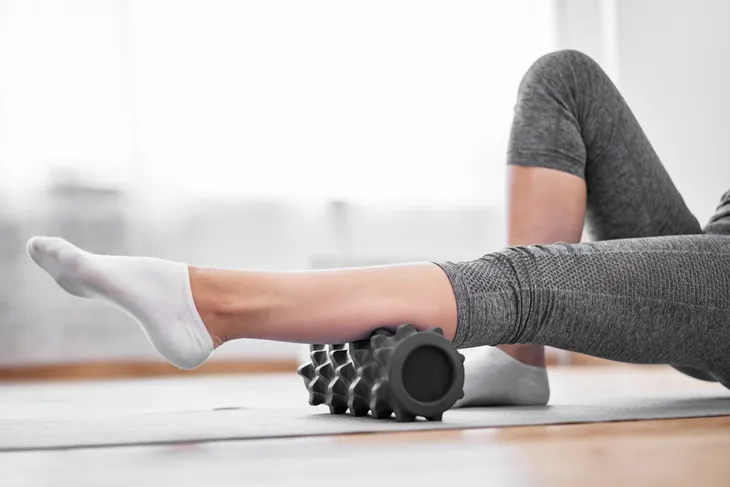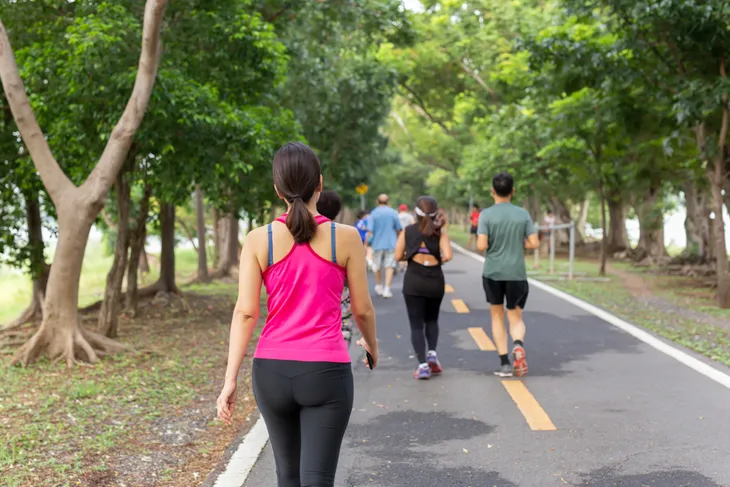For those who’ve experienced sciatica pain before, it’s like a sharp pain that runs from the buttocks down to the back of the leg. Sciatica is a condition referring to impingement of the sciatic nerve which leads to pain and short-term disability. It’s important to determine if the symptoms stem from the back or the sciatic nerve. To help with this, go to a local doctor or physiotherapist. People with sciatica often experience a burning, dull ache, or sharp pain that runs all the way down the back of their thigh.
For most people, the pain of sciatica is worse when bending forward or after long periods of sitting, as well as first thing in the morning. The good news is that sciatica is often short lived and there’s a lot a person can do to decrease the pain! Here are 8 exercises that can help relieve sciatic pain (if you don’t see any improvement after these exercises, go see a doctor for a check up).
Use a Foam Roller
Foam rollers are great for stretching and releasing tension. For sciatic pain, I suggest using a foam roller to stretch and decrease tension in the hamstring, glutes and calves. By releasing these tight muscles, you’ll relieve the tension on the sciatic nerve.
Aim to use the foam roller every morning and night until sciatic pain has full disappeared. The goal is to pick a few areas that are tight and sore on the back of the legs, and use the roller here.
Do Some Glute Bridges
Glute bridges are not only great for strengthening those buttocks, but they can also strengthen the structures that surround the sciatic nerve. By doing glute bridges, you’ll be building strength in the glutes and hamstrings. Activating these muscles around the sciatic nerve will also help stretch the nerve and decrease pain.
Take a Walk
Sometimes all it takes is stretching those legs and going for a walk around the neighborhood! Walking can do wonders when trying to mobilize the sciatic nerve. The aim when walking is to understand how far to push it without causing a flare up in pain. A good general rule is never push into pain when exercising with sciatica.
If you’re finding that you wake up first thing in the morning with sciatic pain, try to complete one of two of the stretches in this list and then head out for a short walk. (Here are some Tips for a Better Walking Workout).
Stretch Your Hamstring
Due to the sciatic nerve traveling along the hamstrings, the tightness in your hamstrings can translate to more sciatic pain. Get into the habit of stretching your hamstrings daily for around 2- to 3-minutes per leg. While stretching, slowly sit into the stretch. As time goes by, you should be able to get deeper and deeper into the hamstring stretch, releasing tension on the sciatic nerve.
Avoid Hard Surfaces
While this isn’t exactly an exercise, it’s good advice for anyone experiencing sciatic pain. Many Americans spend a lot of time sitting, whether it’s commuting to work, sitting at a desk for work, or just not exercising enough at home, these extended periods of sitting can be damaging. For those who can’t avoid sitting, like at work, just make sure you’re not sitting on a hard surface because when we’re sitting, we’re actually compressing the already irritated sciatic nerve.
To complement the following exercises in this list, try to sit on a pillow, folded towel, or a seat topper. Any of these will help avoid hard surfaces. If this doesn’t work, set a timer on your phone or smartwatch to remind you to stand up from your seat every 40-minutes to stretch and move around.
Stretch Your Glutes
The gluteals (buttocks) are the first muscles that the sciatic nerve passed by and or passed through in some people. Therefore, stretching the glutes can do wonders to stop your sciatic pain once and for all.
Much like the hamstring stretches above, aim to stretch each side for 1 to 2-minutes in total and then get on with your day.
Stretch Your Lower Back
The lower back, also called the lumbar spine is where the sciatic nerve originates. By gently stretching your lower back, you should feel the same sciatic pain that you’ve been experiencing. Hold a gentle stretch and once you release, you should feel a gradual improvement in your symptoms.
Getting into the habit of stretching your lower back at the end of each day can help reset your body after a long day of sitting or physical exertion.
Go Swimming
Swimming is a great activity for gentle stretching and activating your muscles as you move through the water. All this movement in the pool will naturally help the sciatic nerve to release its tension and decrease any pain. You can start in the pool by doing low intensity walking of the width of the pool, along with leg kicks holding onto the side, then progress into swimming laps.
To get started, try out one or two of the above exercises. Experiment and find out which exercises work best for you. Good luck!











